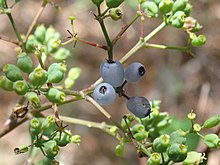Polyscias sambucifolia
| Polyscias sambucifolia | |
|---|---|
 | |
| Polyscias sambucifolia subsp. sambucifolia growing near Brisbane Water National Park, Australia | |
 | |
| Fruit (McKay Reserve, Palm Beach, New South Wales) | |
| Scientific classification | |
| Kingdom: | Plantae |
| Clade: | Tracheophytes |
| Clade: | Angiosperms |
| Clade: | Eudicots |
| Clade: | Asterids |
| Order: | Apiales |
| Family: | Araliaceae |
| Genus: | Polyscias |
| Species: | P. sambucifolia |
| Binomial name | |
| Polyscias sambucifolia Sieber ex DC. Harms | |
| Synonyms | |
| Panax sambucifolius Sieber ex DC. | |
Polyscias sambucifolia, commonly known as elderberry panax or small basswood, is a species of plant native to eastern Australia.
Taxonomy
Elderberry panax was first described by Franz Sieber in 1830 as Panax sambucifolius.[1] It was given its current name in 1894 by German botanist Hermann Harms.[2]
The taxonomy of the small basswood has been reviewed, resulting in the recognition of three sub species: sambucifolia, decomposita and leptophylla.[3]
Common names for these plants include small basswood, elderberry panax, ornamental ash and elderberry ash.[2]
Description
Elderberry panax grows to 11 metres tall with a trunk diameter of 20 cm at Errinundra National Park and Otway National Park in the state of Victoria.
The trunk is straight. Bark is dark brown or black. Fairly smooth, marked by lenticles, pustules and lines.
Leaves
Leaf form varies between different sub forms of this plant. See Plant Net[3] for detailed descriptions between the sub species.
Leaves are pinnate or bipinnate, with leaflets. Between one and six pairs of leaflets on the leaf stem. Leaflets of sub species sambucifolia are toothed, ovate in shape. The other sub species leaves are not toothed.
Leaflets 2 to 20 cm long. Leaves glossy green above, dull glaucous below. A terminal leaflet is seen on the end of the compound leaf.
Leaf stalks vary between 20 mm and no leaf stalk in sub species leptophylla. Leaf shape varies between ovate or elliptic to broad-elliptic in sub species sambucifolia. However the sessile leaflets of sub species leptophylla are oblong linear and somewhat curved (falcate) in shape. Leaf formation is two-pinnate or rarely three-pinnate in sub species decomposita.
Leaf veins evident on both the upper and lower surfaces. Sunken on the top of the leaf, raised below.
Flowers and fruit
The yellow/green flowers form on panicles from December to February. The fruit is an edible globose mericarp, 4 to 6 mm long and mauve or blue in colour. Each contains one or two seeds, 2 mm long. The fruit matures from January to April.
Distribution and habitat
The natural range of distribution is from Cape Otway (38° S) in the state of Victoria to the McPherson Range (28° S), on the border of New South Wales and Queensland. It is often seen on the edge of rainforests.
Ecology
The caterpillars of the elderberry panax leaf roller (Cryptoptila australana) eat the leaves, currawongs eat the fruit, dispersing the seeds afterwards. The species also regenerates from root suckers after bushfire, and suckering has been recorded at other times. It can colonise disturbed habitats.[4]
Uses
Elderberry panax has attractive foliage and fruit.[5]
References
- ^ "Panax sambucifolius Sieber ex DC". Australian Plant Name Index (APNI), IBIS database. Centre for Plant Biodiversity Research, Australian Government, Canberra. Retrieved 11 April 2015.
- ^ a b "Polyscias sambucifolia (Sieber ex DC.) Harms". Australian Plant Name Index (APNI), IBIS database. Centre for Plant Biodiversity Research, Australian Government, Canberra. Retrieved 11 April 2015.
- ^ a b "PlantNET - FloraOnline".
- ^ Benson, Doug; McDougall, Lyn (1993). "Ecology of Sydney Plant Species Part 1: Ferns, fern-allies, cycads, conifers and dicotyledon families Acanthaceae to Asclepiadaceae" (PDF). Cunninghamia. 3 (2): 257–422 [404]. Archived from the original (PDF) on 11 March 2011.
- ^ Hadlow, Barrie (1983). "Polyscias sambucifolia". Growing Native Plants. Canberra, Australian Capital Territory: Australian National Botanic Gardens and Centre for Australian National Biodiversity Research. Retrieved 11 April 2015.
- Floyd, A. G. (1989). Rainforest Trees of Mainland South-eastern Australia (1st ed.). Port Melbourne: Elsevier Australia - Inkata Imprint, copyright Forestry Commission of New South Wales (published 1 December 1989). p. 75. ISBN 0-909605-57-2. Retrieved 20 August 2009. (other publication details, included in citation)
- Polyscias sambucifolia at NSW Flora Online Retrieved 20 August 2009












